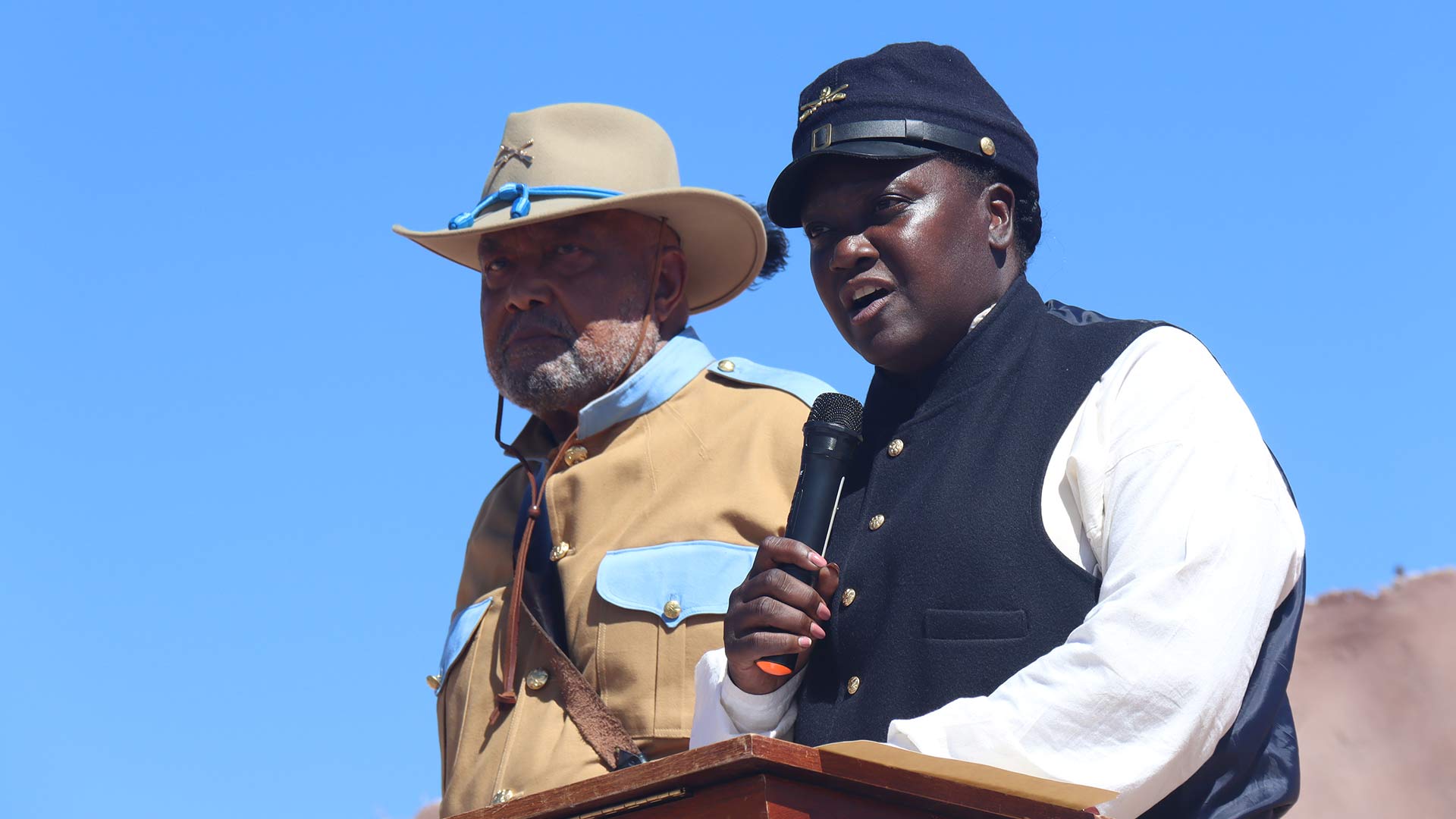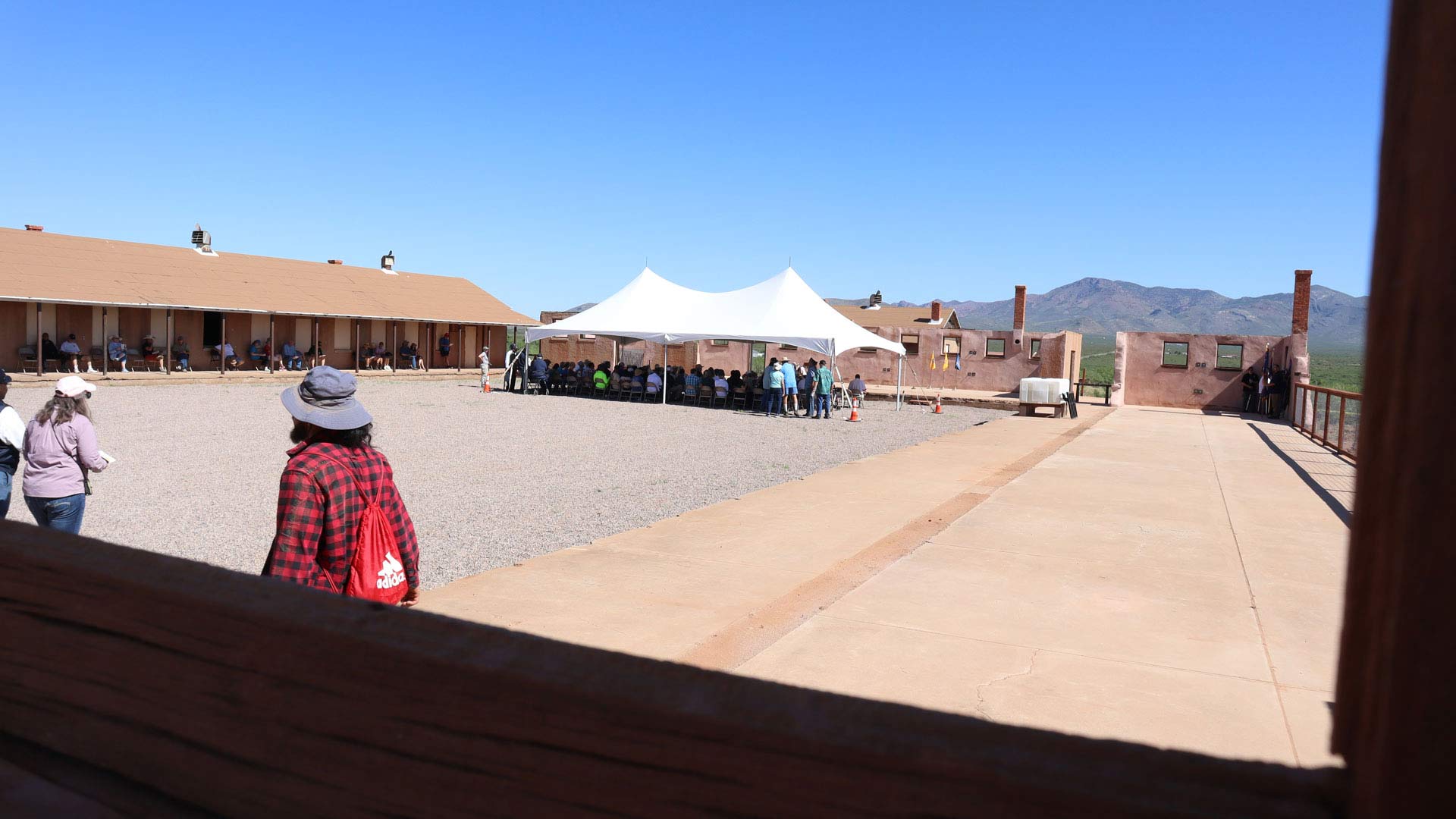 Demetria Warren, President of the Southwest Association of Buffalo Soldiers (right), read the 1948 executive order signed by President Harry Truman to integrate the armed forces during the celebration of Buffalo Soldiers Day at Camp Naco. August 5, 2023. Photo by Summer Hom, AZPM News.
Demetria Warren, President of the Southwest Association of Buffalo Soldiers (right), read the 1948 executive order signed by President Harry Truman to integrate the armed forces during the celebration of Buffalo Soldiers Day at Camp Naco. August 5, 2023. Photo by Summer Hom, AZPM News.
The historic Camp Naco was established as a satellite military base to Fort Huachuca during the Mexican Revolution and was home to the Ninth and Tenth Cavalry of Buffalo Soldiers. While the adobe still stands, much of that history is still trying to gain the spotlight.
Two grants, which total $8.1 million dollars, are aiding historians' plans to revitalize the historic area into a community gathering place and museum.
In 1992, Congress designated July 28th as Buffalo Soldiers Day to commemorate the passage of the Army Reorganization Act, which was passed in 1866 and established six all-Black regiments that became known as the Buffalo Soldiers. The law created the ninth and tenth cavalry units which were stationed at Camp Naco.
The base was established to guard the U.S.-Mexico border and protect American citizens and the economic functions of the railroad during the Mexican Revolution in 1910.
“Part of that was racial, they were kinda getting them out of the sight," said Rebecca Orozco, the Community Coordinator and board member for the Naco Heritage Alliance. "But it also was because they were the major part of the U.S. Military left.”
The Naco Heritage Alliance is a 501c3 tasked with preserving Camp Naco. Orozco said has been working to preserve the site since 1998.
“And these jobs were good jobs for them (Buffalo Soldiers)," Orozco added. "They had pushed through, during the war, the equality of pay for the Black soldiers. So, they were hitting $13 dollars a month, which at that point was good.”
Strategic Planning Consultant with the Naco Heritage Alliance Brooks Jeffery said the celebration at Camp Naco on Saturday also celebrated the 75th anniversary of the executive order President Harry Truman signed in 1948 that integrated the Armed Forces.
This year’s celebration at Camp Naco was delayed, due to the July passing of former Southwest Association of Buffalo Soldiers President and Army Sergeant First Class Thomas Stoney Sr.
J.C. Mutchler, who was an associate research historian at the University of Arizona who worked to preserve Camp Naco, also passed away this year. Both were honored during Saturday's event.
 Around 100 attendees gathered at Camp Naco Saturday to celebrate Buffalo Soldiers Day. August 5, 2023. Photo by Summer Hom, AZPM News
Around 100 attendees gathered at Camp Naco Saturday to celebrate Buffalo Soldiers Day. August 5, 2023. Photo by Summer Hom, AZPM News
Demetria Warren, who’s the current president of Southwest Association of Buffalo Soldiers said the day’s significance lies in breathing life into the spirit of the Buffalo Soldiers and sharing that with the next generation.
"You can’t forget your past," Warren said. "You know why you can’t forget your past? …It is natural growth and progression that we continue to pass these things on. So, that is why this is so significant that we stay here, keep these things alive. You can put your hands on it and feel it, you can walk around and feel that spirit of that resilience and honor and courage."
Camp Naco encompasses a 17-acre area, located 600 yards north of the U.S.-Mexico border. The land was originally owned by John J. Newell, who was one of the first landowners in the Naco township in Arizona after it was incorporated in 1898.
The initial camp in 1910 was only a tent camp. But by 1919, the government had decided to make it a permanent military camp after the discovery of the Zimmermann Telegram — a coded telegram sent by the German foreign secretary to the German minister in Mexico with the intent of forming an alliance with the Mexican government if the United States decided to declare war on Germany during World War I according to Encyclopedia Britannica.
In 1919, the adobe buildings were constructed at Camp Naco.
Orozco said she sees one of the main tipping points of the Mexican Revolution as the Battle at Naco. She said none of the Buffalo Soldiers were directly involved in that fighting, but they cared for the wounded and refugees.
“The longest battle of the Mexican Revolution took place in Naco, and there were three major battles there," she said. "The historian in me thinks that the Battle of Naco of 1914-1915 — a one-hundred and fifteen-day battle — was the turning point in the revolution. Because at that point, the U.S. as they were here were trying to keep neutral, keep the bottle on that side of the border."
Orozco said 42 people at Camp Naco, including some of the Buffalo Soldiers, were wounded from crossfire, but none were killed.
“The U.S. was supporting Pancho Villa at that point," Orozco continued. "They pressured him to go to the negotiation table and pull out of that battle. Following that, he lost at Celaya, the U.S. decided to switch sides. And that led him to attack Columbus, New Mexico.”
Since then, the Camp has been occupied by relatives of the Newell family. After senior members of the Newell family decided to sell the property to Vision Quest in the late 1980s, it then was acquired by the town of Huachuca City, which then decided to deed it to the city of Bisbee in 2018.
 Strategic Planning Consultant with the Naco Heritage Alliance Brooks Jeffery (left) and Rebecca Orozco, the community coordinator and board member for the Naco Heritage Alliance (right) talk about the four-year plan to use the $8.1 million to restore the site as a community space, museum and library. August 4, 2023. Photo by Summer Hom, AZPM News.
Strategic Planning Consultant with the Naco Heritage Alliance Brooks Jeffery (left) and Rebecca Orozco, the community coordinator and board member for the Naco Heritage Alliance (right) talk about the four-year plan to use the $8.1 million to restore the site as a community space, museum and library. August 4, 2023. Photo by Summer Hom, AZPM News.
Over the years, three different fires have damaged parts of the property. Orozco and the alliance have tried to secure enough funding to repair and maintain the site.
Last year, the National Trust for Historic Preservation named Camp Naco to the 2022 list of America’s 11 Most Endangered Historic Places. Following that designation, the State of Arizona awarded the city of Bisbee $4.6 million and the Mellon Foundation gave Camp Naco $3.5 million for restoration.
The Mellon Foundation chooses two historic sites annually off the National Trust for Historic Preservation's list of 11 Most Endangered Historic Places to award grants to. Both grants were awarded last year.
Orozco said the plan is to turn the building that was the field hospital into a museum, make the old officers club a library and community meeting space, mess dining hall into a stage, and turn the barracks into art studios. The rest of the funds, which they have for four years, will be used to stabilize the adobe and create public restrooms in the wash houses.

By submitting your comments, you hereby give AZPM the right to post your comments and potentially use them in any other form of media operated by this institution.